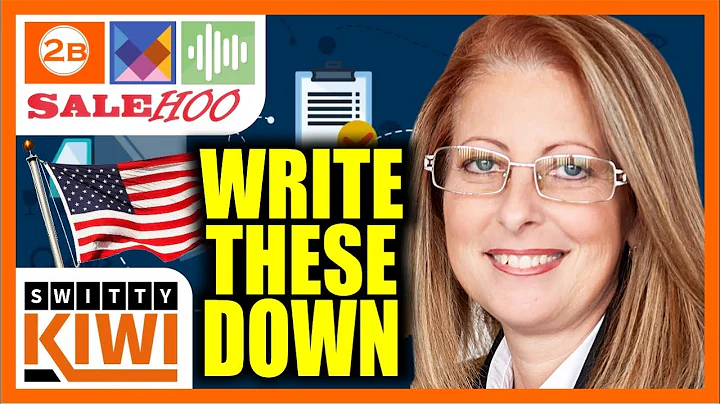Start Your Amazon Dropshipping Journey Today
Table of Contents
- Introduction
- Setting Up an Amazon Account
- Product Research
- Finding Suppliers
- Becoming an Amazon Seller
- Adding Products to Amazon
- Importance of High-Quality Product Images
- Utilizing Keywords for Better Sales
- Managing Orders and Shipping
- Pros and Cons of dropshipping on Amazon
Dropshipping on Amazon: A Step-by-Step Guide for Beginners
Dropshipping has become a popular business model, and Amazon provides an excellent platform for beginners to start their dropshipping journey. In this article, we will guide you through the process of setting up a dropshipping business on Amazon, from creating an account to managing orders and shipping. So, let's get started!
1. Introduction
Dropshipping allows you to sell products online without the need for inventory or shipping. Instead, you act as a middleman between customers and suppliers. When a customer places an order, you forward the order details to your supplier, who then ships the products directly to the customer. This eliminates the need for storing and managing inventory, making it an attractive option for aspiring entrepreneurs.
2. Setting Up an Amazon Account
To start dropshipping on Amazon, you'll need to create an Amazon seller account. Visit amazon.com and sign up for a new account by providing your email and verifying it. Once you're logged in, you'll have access to the main dashboard where you can manage your products and orders.
3. Product Research
Before you can start dropshipping, you need to choose the products you want to sell. Conduct thorough product research to ensure you select popular and in-demand products. Use search engines like Google to identify product trends and determine what customers are currently looking for. For example, during the holiday season, Christmas decorations sell the most. Consider using tools like Pinterest to find relevant keywords that potential customers are using in their searches.
4. Finding Suppliers
Once you have identified the products you want to sell, the next step is finding reliable suppliers. Alibaba and AliExpress are two well-known platforms where you can find suppliers. Alibaba is a Chinese multinational technology company, while AliExpress is an online retail service also owned by Alibaba Group. Both platforms offer a wide range of suppliers and products. It's essential to choose a supplier that can ship products directly to your customers.
5. Becoming an Amazon Seller
To start selling on Amazon, you need to apply as a seller. On your Amazon account, click on the "Sell" option and apply to become a seller. You will need to provide a valid government ID or passport, a recent bank account or credit card statement, and a chargeable credit card. Amazon will verify your submission, and once approved, you can start selling.
6. Adding Products to Amazon
To attract customers, you need to create compelling product listings on Amazon. Make sure you have high-quality product images that showcase your products effectively. If the images provided by the supplier are not clear, request a clearer image directly from them. Additionally, optimize your product titles and descriptions using relevant keywords that customers are likely to search for on Amazon.
7. Importance of High-Quality Product Images
High-quality product images are crucial for attracting customers and increasing sales. Clear and visually appealing images provide customers with a better understanding of the product. They help create a positive impression and build trust. Ensure your product images are of high resolution and accurately represent the product you're selling.
8. Utilizing Keywords for Better Sales
Keywords play a vital role in improving visibility and sales on Amazon. Incorporate relevant keywords in your product titles and descriptions to increase the chances of appearing in search results. Research popular keywords related to your products using search engines and platforms like Pinterest. By using the right keywords, you can drive more traffic to your product listings and attract potential customers.
9. Managing Orders and Shipping
As a dropshipper on Amazon, it's essential to carefully manage your orders and shipping process. When a customer places an order, you need to promptly forward the order details to your supplier. The supplier will handle the packaging and shipping of the products directly to the customer's address. Stay in communication with your supplier to ensure timely and accurate order fulfillment.
10. Pros and Cons of Dropshipping on Amazon
While dropshipping on Amazon offers many benefits, it also has its drawbacks. Let's explore some of the pros and cons:
Pros:
- No need for inventory management or storage space
- Low startup costs
- Access to a vast customer base on Amazon
- Ability to sell a wide range of products
Cons:
- High competition on Amazon may affect profit margins
- Reliance on suppliers for timely order fulfillment
- Limited control over shipping and customer experience
- Amazon's fees and policies may impact profitability
Overall, dropshipping on Amazon can be a profitable venture with careful planning and execution. It's crucial to weigh the pros and cons and develop strategies to overcome challenges.
Highlights:
- Dropshipping provides an opportunity to sell products online without inventory.
- Product research is crucial for identifying popular and trending products to sell.
- Alibaba and AliExpress are reputable platforms to find suppliers.
- Becoming an Amazon seller requires completing a verification process.
- High-quality product images and relevant keywords improve sales.
- Careful order management and communication with suppliers are necessary for successful dropshipping.
- Pros of dropshipping include low startup costs and a wide customer base, while cons include high competition and limited control over shipping.
FAQ
Q: How do I choose the right products to sell on Amazon?
A: Conduct thorough product research to identify popular and trending products. Consider factors like demand, competition, and profit margins when making your decision.
Q: Can I use multiple suppliers for my dropshipping business on Amazon?
A: Yes, you can work with multiple suppliers to diversify your product offerings and mitigate risks associated with relying on a single supplier.
Q: How do I handle returns and customer inquiries as a dropshipper on Amazon?
A: As a dropshipper, it's essential to have clear communication channels with your suppliers. Coordinate with them to handle returns or address customer inquiries promptly and efficiently.
Q: Are there any restrictions on the types of products I can dropship on Amazon?
A: Yes, Amazon has specific guidelines and restrictions on certain products, such as restricted categories and branded items. Familiarize yourself with Amazon's policies to ensure compliance.
Q: How can I stand out among other sellers on Amazon?
A: Focus on offering excellent customer service, optimizing your product listings, and utilizing effective marketing strategies, such as sponsored ads and promotions, to differentiate yourself from competitors.



















